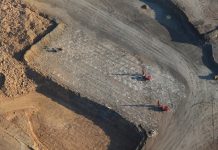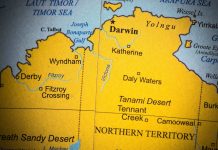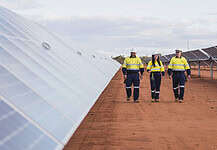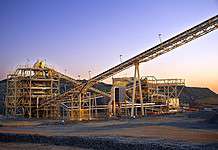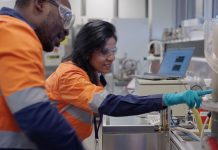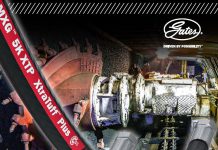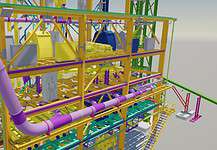By Samantha James
CUDECO is among only a handful of companies to have solely steered a major Australian project from discovery to production.
The Rocklands Group copper project near Cloncurry in Queensland has been a long-term investment for CuDeco, following the discovery of a previously-unknown zone within historical workings in 2006.
Under CuDeco’s direction the newly discovered copper, cobalt and gold mineralisation at Las Minerale quickly grew, with the project soon taking in the Central Rocklands and Southern Rocklands areas, together referred to as the Rocklands Group.
The ore exhibited large zones of high-grade coarse native copper ore co-mingled with oxide, supergene, transitional and primary copper ores, making it unique and the first of its kind discovered in Australia.
CuDeco began mining hard rock ore in 2012 following free-dig mining activities and studies into an initial 10-year mine plan involving a 3 million tonne per annum plant capable of processing all ore types found at the project.

Construction of the process plant began the same year; however, EPC contractor and shareholder Sinosteel Equipment and Engineering experienced a number of delays, leading to additional funding requirements in 2014 and 2015.
Securing financing caused further setbacks to work on the process plant, which was initially scheduled for completion by the end of the 2015 financial year.
By December 2015 construction and pre-commissioning activities were nearing completion and stockpiles had reached more than 2.2mt of material ready for processing.
Final commissioning of the process plant was now scheduled for early 2016 with the first shipment contracted to a Chinese buyer.
Expanding targets
The 2011 mining lease permit approval for Rocklands outlined a small, high grade open pit operation with an eight year mine life, with copper processed at the 3mtpa plant for 10 years, with the last two years treating ore from stockpiles.
However a second stage underground operation remained a possibility pending further studies.
CuDeco’s process plant was designed in response to the unique ore types found at the project, with the inclusion of both three-stage primary and tertiary crushing and high pressure grinding rolls circuits specifically designed to handle coarse native copper ore as well as the standard flotation circuits and magnetic separators, making it the world’s largest native copper gravity circuit.
The plant would treat all ore types identified at Rocklands concurrently, producing five co-products including copper, cobalt, gold pyrite and magnetite in four saleable concentrates.
A scoping study undertaken in late 2015 showed sufficient capacity in the major equipment items, and found that with minimum plant modification the processing plant could be upgraded to a 4.5mtpa throughput rate.
For the life of mine, CuDeco anticipated the majority of revenue would come from copper, with testwork returning high recoveries of 95 per cent native copper at processing costs of $13.84 per tonne.
With 30mt of identified resources, Rocklands had the potential for several expansion and continuation options which CuDeco was further investigating in a feasibility study in 2015.
As part of the study, CuDeco released a maiden ore reserve in December 2015 totalling 28mt grading 0.9 per cent of copper equivalent, equating to 252,000t of contained copper metal equivalent.
This comprised 199,000t of copper, 126,000oz of gold, 10,000t of cobalt and 1.9mt of magnetite.

The Rocklands feasibility study indicated that the project was technically and economically viable for the metal prices assumed. Full results were set to be released during the first quarter of 2016.
CuDeco chairman David Taylor said that the company was ready for the transition from explorer and developer to miner.
“2015 has been a major year in CuDeco’s development as Australia’s next copper exporter,” he said.
“2016 will be the year in which we achieve this goal, and I hope [our shareholders] will benefit for years to come.”
Mr Taylor said that first commercial shipments of concentrate – scheduled for early 2016 – would mark a milestone for the company and the state.
“Importantly for Cloncurry and the state, Rocklands will generate around 180 jobs at full production, which will create up to 400 new jobs in the North Queensland region due to economic spin-offs,” he said.
“CuDeco has already injected significant amounts into the Queensland economy, while Rocklands will also contribute millions of dollars of royalties over its operational life, highlighting the importance of the mining industry to the state.”
Funding
In May 2015 CuDeco signed an agreement with Focus Sun Holdings for funding to finance completion of the Rocklands processing plant. This was in addition to an existing finance facility held with Minsheng bank.
The $50 million subscription agreement would have taken Focus’ shareholding in CuDeco to 18 per cent.
At an extraordinary general meeting, held at the end of June, the agreement was rejected by CuDeco’s shareholders, including its Chinese investors New Apex and Sinosteel, despite the transaction having received Foreign Investment Review Board approval.

Instead, the company secured $83 million in funding via an agreement with its three major Chinese investors, allowing for construction and commissioning activities to recommence.
Sinosteel Equipment and Engineering (6.23 per cent shareholder), China Oceanwide International Investment (19.7 per cent shareholder) and New Apex Asia Investment (8.8 per cent shareholder) confirmed support of operations with the initial transfer of a $3 million bridging loan.
As part of the agreements, CuDeco applied to withdraw further funds under agreements with Minsheng Bank, taking the facility to US$100 million.
To assist with this, CuDeco’s major Chinese shareholders supplied the bank letters of support for the additional drawdowns, on the condition that chairman and chief executive Wayne McCrae resigned.
As part of the agreements, several other changes were made to the board, including the appointment of a Sinosteel representative.
Sinosteel assisted further by agreeing to a delayed payment for part of the electrical contract.
“The past year has seen some changes at CuDeco,” Mr Taylor said.
“Our project is set to commence production soon, delivering substantial revenues for shareholders’ benefit; we have revitalised our management and board with an experienced new team and we have gained the necessary investment to secure out company’s financial future.”
In September 2015 CuDeco announced an $88 million rights issue to fund further activities; however in October the company was notified of an application to the Australian Government’s Takeovers Panel, made by a shareholder with the intention of preventing the transaction.
The application was made on the basis that the major shareholders would have an undisclosed controlling effect on the company should the placement proceed.
A revised non-renounceable rights issue was then announced to raise $63 million.
This was made following a $30 million share placement to Rich Lead Investment earlier in the month, giving the Singaporean company an 11.9 per cent stake in CuDeco.
With both placements closed by the end of January 2016, CuDeco flagged the end of its capital raising troubles and another step forward in the transition to production.

